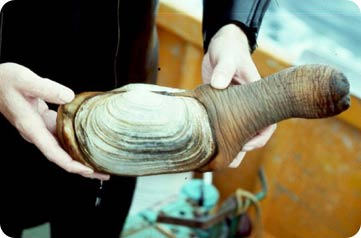170410-geoduck.jpg

The world's largest burrowing clam - the geoduck. Credit: Neil Bourne Fisheries and Oceans Canada
Smugglers sneak tons of it out of the country every year. Other ne’er-do-wells under-report the amount of it they’ve sold on their incomes taxes, and even trade drugs for it. Is it diamonds? Gold? Lady Gaga CDs?
How about the world’s largest burrowing clam -- a monster with a three-foot neck that can live for more than a century. It’s a delicacy on both sides of the Pacific Ocean -- fetching up to $60 a pop in parts of Asia.
The geoduck is found in several spots around the world, but it’s most common -- and grows biggest -- off the coasts of Washington and British Columbia. More than a hundred million of them live in Puget Sound alone.
The name “geoduck” comes from an American Indian name that means “digs deep.” A geoduck burrows into the silty ocean floor at an age of just a few weeks -- and it keeps on digging. Over the years, it can burrow to a depth of about three feet.
Geoducks feed through a long, rubbery neck known as a siphon, which pokes through the silt. It sucks in water through one tube in the siphon, feeds on the water’s microscopic plants, then shoots out the filtered water through a second tube.
The average geoduck weighs a couple of pounds, but there are reports of a few growing up to eight pounds or heavier. And they may live up to 150 years.
Geoducks are harvested by divers, who drop to depths of about 70 feet and blast away the silt with high-powered jets of water. They gather several million pounds of geoducks a year. Then it’s off to the market -- legally or illegally.

